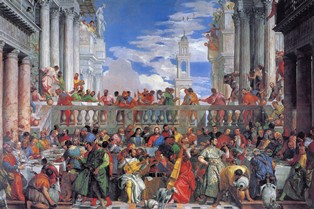
WTI Magazine #47 2014 November, 12
Author : Enrico De Iulis Translation by:
2014 will be remembered in the world of Italian art as the year of Paolo Caliari, known as "Veronese". After decades of absence regarding him, Verona hosted a beautiful and comprehensive exhibition about the painter who more than any other has been linked to his hometown.
Veronese, along with Titian, imposed a "trademark" on Venetian painting and an always recognizable style and technique: it is not by chance that these two geniuses of the Venetian sixteenth century left to posterity two colors that bear their names, titian red and Veronese green, an art legacy based on colors, exalted by colors and exploding in colors.
But Veronese is much more and the exhibition at the Gran Guardia Palace in Verona clearly shows it. The paintings came from all the major museums in the world; the ones from Veneto have been restored for the occasion; the designs correlate and explain the process of composition of Caliari, to outline the profile of this immense artistic painter, deeply active in the cultural climate of the Venetian mid sixteenth century, thanks to the tight friendship with two of the key figures of the time: Andrea Palladio, the Venetian architect par excellence, and Daniele Barbaro, the translator of "De Architectura" by Vitruvius.
This will bring an extreme attention at the reproduction of architecture, its prospects, its relationship with the human figure. He will become a master in glimpses, in proposing figures, all enhanced by an innate sense of the juxtaposition of primary colors with the secondary ones. Violet and yellow, green and red gloomy cold, pale blue and orange loads: Veronese mated them, carried them forward or backward surrounded by white candid lowering the tone of the contours. In the exhibition there is all this, the creation of his style through works that will not come back easily to Italy.
Vicenza, instead, offered a truly rare experience: four paintings of the same production, and divided by centuries, have been brought together not only to analyze their style, but also from a philological and iconographic point of view. Two of them are from Los Angeles and two from a villa in Verbania: they are depicting allegories of scientific measurement and sculpture, absolute beauty in the charm of a still not entirely clear mystery: where were these works, originally? And how many of them there were?
In Padua, another compelling story in the exhibition of Veronese and his Paduan clients was shown at the "Museo degli Eremitani" (Hermits Museum). Along the way one would find the "Ascension of Christ": the painting was stolen in the early 1600s, cut by removing the bottom of it, which made a journey from hand to hand and only fifty years ago it was recognized by a Slovenian art historian as the cut of this work, which since then had been replaced by an intervention of Pietro Damini. Now you can see the two versions one next to the other, tracing the adventures that seem to be a characteristic of the works of Paolo Caliari, rightly celebrated throughout the Veneto region as one of the fathers of the Italian chromatic taste.



